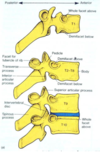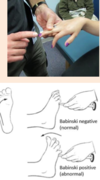12 - Cervical and Thoracic Spine Flashcards
What is the structure of a typical cervical vertebrae?
- Typical are C3-C6
- Triangle foramen
- Transverse forman transmits vertebral artery, vein and sympathetic nerve plexus C1 - C6
- C7 foramen only transmits vertebral vein

How are the facets arranged in the cervical and thoracic spine?
C: In the coronal plane 45 degrees to the axial
T: 60 degrees to axial, 20 degrees to coronal

What is the structure of C1 and what is it called?
- Atlas
- No body or spinous process
- Superior articulating surface is large to support the head, they are the lateral masses that articulate with occipital condlyles of skull

What movements do the atlanto-occipital and atlanto-axial joints permit?
AO: 50% of nodding (flexion and extension), the rest coming fromt the other cervical
AA: 50% of total rotation of head and neck
What is the structure of C2 and what else is it called?
- Axis
- Dens is remnant of C1 body
- Can recognise C2 on X-ray by first protuding spinous process

How is the atlanto-axial joint stabilised and what happens if this joint is destabilised?
- Apical ligament between odontoid process and base of skull
- Transverse ligament and odontoid process preventing horizontal displacement of atlas on axis
- Atlantoaxial instabilitiy with congenital, trauma, rheumatoid arthiritis which can compress the spinal cord

How do the spinal nerves in the cervical region run in relation to the vertebral artery?
- Run posteriorly to the vertebral artery, which goes through foramen transversium
- Groove for nerve across superior pedicle between anterior and posterior tubercles

What is the structure of C7?
- Longest spinous process that can be seen in flexion
- Spinous process not bifid
- Foramen transversarium only transmits accessory vertebral veins

How do spinal nerve roots in the cervical region leave the vertebrae?
- Above their corresponding vertebrae until C7/T1
- If disc prolapse in C3/C4 then C4 would be affected

What is the ligamentum nuchae and what are it’s roles?
- Roles: Maintain secondary curvature of cervial, assist cervical and support weight of head, site of attachment for major muscles
- Thickening of the supraspinous ligament from external occipital protuberance of the skull to the spinous process of C7

What are the ligaments of the cervical and thoracic spine?

What movements can take place in the cervical spine
- Due to being 45 degrees to axial plane
- Rotation at atlanto-axial
- Flexion and extension at atlanto-occipital

What is the structure of the thoracic vertebrae?

- Heart shaped body
- Costal facets T1 to T10
- Demi facets (T2 to T8) or whole facets (T1, T9, T10)
- Spinous process angles inferiorly
- Facets 20 degrees to coronal, 60 degrees to axial

What are the ribs that come from the thoracic spine attached to?
- Come round front and attach to sternum (T1 to T7)
- Costal cartilages of the ribs above them (T8 to T10)
- Do not have anterior attachment, just terminate in abdomen to protect kidneys (T11 to T2)

What vertebrae would rib 5 articulate with?
- Costal demifacets of T4 and T5 found on the transverse processes
- Cartilage lined demifacets

Which thoracic vertebrae have atypical costal facets?
- T1: whole facet superiorly as rib 1 only articulates her
- T9 and T10: only have one whole costal facet and articulate with their own rib
- T11 and T12: have one whole costal facet on their pedicle not transverse process

What movement is permitted in the thoracic spine?
- Lateral flexion
- Rotation
- NO FLEX AND EX

How are the facets of the lumbar spine orientated and what movement does this permit?
- 95 degrees to axial plane
- 45 degrees to coronal plane
- Large amount of flexion and extension and a little bit of rotation
What is cervical spondylosis?
- Degenerative OA of intervertebral joints in cervical spine
- Age related disc degeneration, followed by osteophytes then facet joint OA
- Narrowing of intervertebral foramina can lead to radiculopathy and narrowing of spinal canal can lead to myelopathy

What is cervical radiculopathy?
- Compression of nerve roots due to issues with intervertebral foramine, e.g syndesmophytes
- Dermatomal sensory symptoms (paraesthesia and pain)
- Myotomal motor weakness

What is cervical myelopathy?
- Narrowing of spinal canal putting pressure on spinal cord
- Global muscle weakness, gait dysfunction, loss of balance, loss of bowel/bladder control
- Rare in cervical spondylosis

What is the differences between a slipped disc in the lumbar region and slipped disc in the cervical region?
- Lumbar region tends to be due to strenous activity but cervical just wake up with stiff neck
- Cervical more common in young, lumbar more common in old

What is a Jefferson’s fracture?
- Fracture of anterior and posterior arches of C1
- Axial loading e.g diving into shallow water, falling from playground equipment
- Often supporting head with their hands when in ED with pain
- Rarely neurological symptoms as bursting open prevents impingement on spinal cord
- Secondary neurology if damage to arteries at base of skull, e.g stroke, horners

What is Horner’s syndrome?
Damage to the sympathetic trunk leading to miosis, partial ptosis, anhidrosis, enophtalmos














